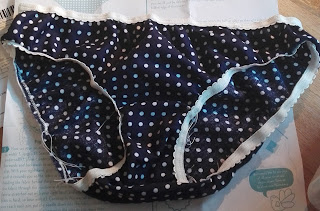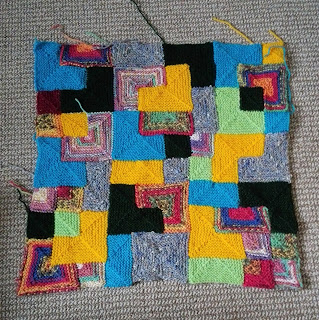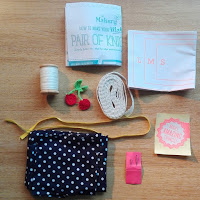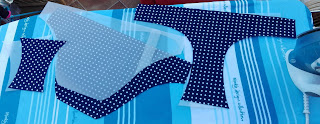
Recently I was tasked with making a knitted cushion cover. I took this as a good way to try something new, so off I went to the library and trawled through a load of books on knitting (old fashioned I know, but I love the library!) and found out about mitred knitting, and I decided to make my own pattern for a cushion cover using different colour pieces of yarn to create a square pattern with a twist!
For those who are unfamiliar with the idea of mitred knitting, it's a way to knit several pieces of yarn together with little to no sewing the parts together.
What I found out was that there is a way to make about three different shapes, a big square, and L shape, a rectangle and a little square, all with the same base pattern.
The base pattern starts with the small square and the other shapes are done by repeating the pattern of the small square.

To start with one of the following shapes needs to be knitted on its own, I started with a small square as I found it easier but there are no rules as to what you can and can't knit! After one of the squares has been knitted, the next one is knitted, but when casting on loops are made through the edge of another square. This joins the two squares together, with no sewing.
The small square pattern is:
Cast on 19 sts
Row 1 and every odd row: k to last st, sl 1 pwise wyif. (The ending to this I've explained
here in my scarf pattern.)
Row 2: k8, sl1, k2tog, psso, k7, sl1 pwise wyif (17)
Row 4: k7, sl1, k2tog, psso, k6, sl1 pwise wyif (15)
Row 6: k6, sl1, k2tog, psso, k5, sl1 pwise wyif (13)
Row 8: k5, sl1, k2tog, psso, k4, sl1 pwise wyif (11)
Row 10: k4, sl1, k2tog, psso, k3, sl1 pwise wyif (9)
Row 12: k3, sl1, k2tog, psso, k2, sl1 pwise wyif (7)
Row 14: k2, sl1, k2tog, psso, k1, sl1 pwise wyif (5)
Row 16: k1, sl1, k2tog, psso, sl1 pwise wyif (3)
Row 18: sl1, k2tog, psso, cut yarn and pull through last stitch to cast off.
To make any of the larger sizes the square pattern is repeated, so to make the rectangle the pattern will start:

Cast on 38.
Row 1: k38
Row 2: k8, sl1, k2tog, psso, k8, k8, sl1, k2tog, psso, k7, sl1 pwise wyif.
The 'L' shaped size has three repeats, and the large square four in the style mentioned above. I find it easier when working a square made up of more then one little square, to put stitch markers every 19 stitches, so I can easily see where to start and finish the repeat of the pattern.
Now to actually join the the squares together the second has to be knitted onto the first, this is done when casting on, as loops are pulled through the edges of the first square. Lets say we wanted to add another small square to our first small square.
To start with cast on 9 stitches on your needle, the 10th stitch should be in the corner of the square. The next 9 stitches are pulled through the edge loops of the square, under the two pieces that make the neat straight edge:
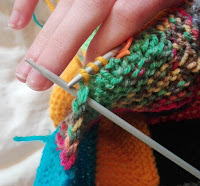 |
| Needle passed under edge loops |
When I'm casting on stitches through the first square, I always pull them through from the front, which means that the messy bit is at the back. To do this I find it easier to swap the needles over in my hands, and sort of knit the loops as if they were another stitch!
Most of the cast on rows that I knit onto other squares have a mixture of stitches both through the side of the previous square and just cast on to the needle.
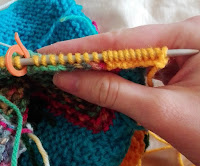 |
| Both loops and cast on |
With this style of mitred knitting a huge variety of different shapes can be made, and some really nice effects achieved. The cushion case I am covering is 20 inches by 20 inches, so I had a large square to try and knit. With my tension and using double knit wool with size 9 needles, the small square measures 2 inches by 2 inches, so I drew out on square paper a large square, which was 20 squares by 20 squares on the paper, and I drew out within that square the shapes and sizes of the smaller squares made using this pattern to make the large cushion cover size!
If you are planning to make something to a specific size like a cushion cover then it would be best to knit one square with the wool and needles that you plan to use, then measure the square and you then will have an idea of how many squares and how large you need to make the final piece.
The beauty of this pattern is that when making something larger, you can plan it out and stick to the design you've planned, or just grab the needles and wool and knit whatever you decide is best next, and all variations are easy to do, and the spontaneous nature of the project can be really fun!
I haven't completely finished the cushion cover yet, but I am most of the way there, and with it laid out you can get a good idea of the finished product, I'm now excited to get it all done and put together.
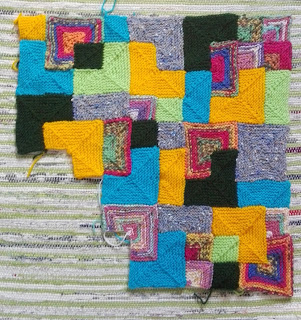 |
| The Nearly Finished Cover |
 I've made a little bit of progress on the Granny Stripe Blanket, it's now a whole three rows taller! (Hopefully more soon as I finish more bits and pieces off) To read more about that one check it out here.
I've made a little bit of progress on the Granny Stripe Blanket, it's now a whole three rows taller! (Hopefully more soon as I finish more bits and pieces off) To read more about that one check it out here.
